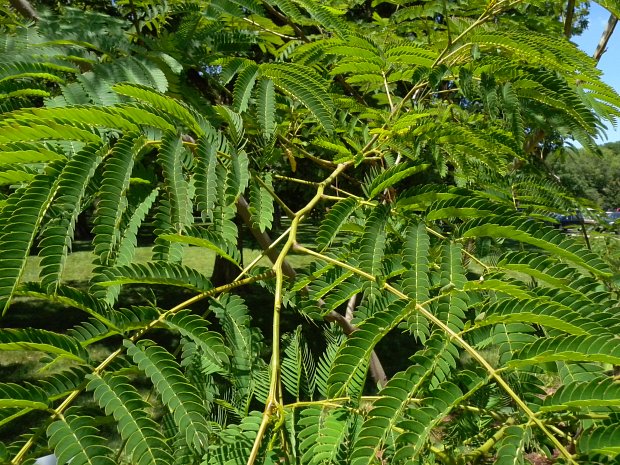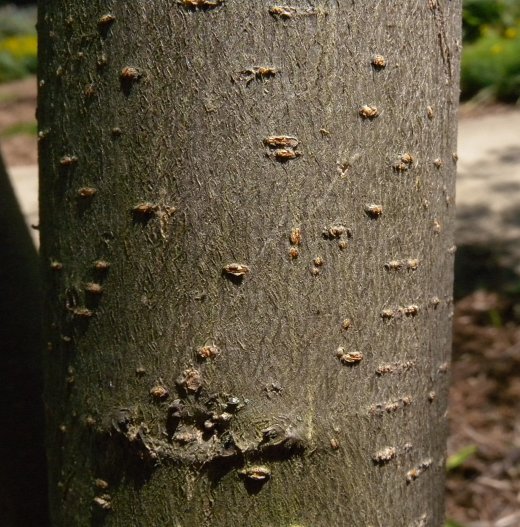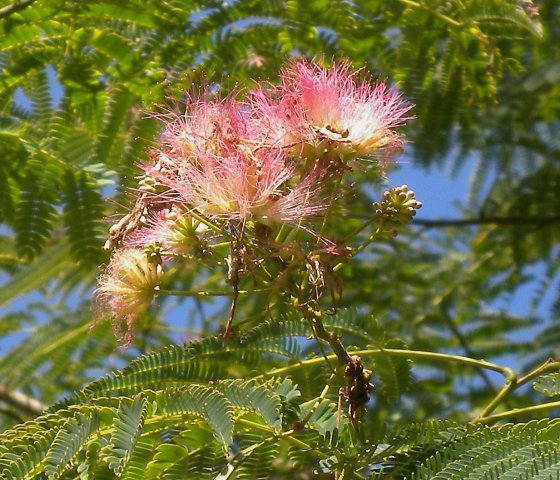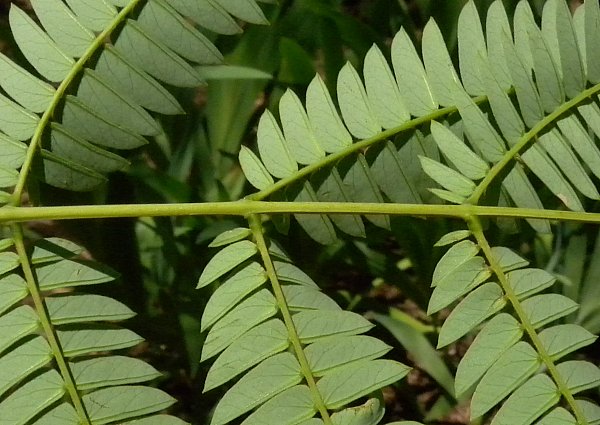Persian Silk Tree
Albizia julibrissin
Mimosa family (Mimosaceae)
Albizia julibrissin
Mimosa family (Mimosaceae)
Description:
This is a small tree or large shrub up to 40' (12.2 m.) tall that is
either single-trunked or several-trunked. It usually has a widely
spreading and flat-topped crown that is somewhat open. Trunk bark is
light gray and relatively smooth with scattered light-colored
lenticels, while branches are are light gray to brown and relatively
smooth with scattered light-colored lenticels. Young twigs are terete
to angular, light green to light yellowish green, and usually finely pubescent; they become
more gray or brown and hairless with age. The twigs tend to zigzag
between the alternate compound leaves. The leaves are bipinnate
with an even number of pinnae and leaflets. Individual leaves are up to
1½' (0.45 m.) long and similarly across, consisting of 6–12 pairs of pinnae
and each pinna having 15–30 pairs of leaflets.

Individual leaflets are 8–13 mm. long and 1.5–4 mm. across; they are asymmetrically oblong in shape and smooth to slightly short-ciliate along their margins, tapering to acute tips. The upper leaflet surface is medium green and hairless to sparsely hairy, while the lower leaflet surface is light green and hairless to sparsely hairy. The leaflets often fold upward along their midveins, although the latter are unusual in being located closer to their outer margins The rachis and petioles of the leaves are light green to light yellowish green, angular in cross-section, and usually finely hairy or pubescent. The petioles are typically 1½–3" (4–7.5 cm.) long, and each one is swollen at the base with a lozenge-shaped gland. Very compact racemes of flowerheads are produced on peduncles ¾–2" (2–5 cm.) long. The flowerheads span 1½–2" across (including the stamens), forming a hemispherical or wide obconic shape, and each flowerhead contains about 12–30 flowers that are perfect or staminate. The calyx of each flower is 2–4 mm. long, tubular in shape with 5 lobes along the upper rim, light green or yellowish green, and hairless or finely hairy. The corolla of each flower is 7–8 mm. long, tubular in shape with 5 lobes along the upper rim, and greenish white. Each flower also has 20 or more slender stamens that are ¾–1" (2–2.5 cm.) long; they are white toward their bases, becoming pink or reddish pink toward their tips.

The blooming period occurs during the summer, lasting 1–2 months. If successful cross-pollination occurs, each flowerhead will develop one or more drooping seedpods. Individual seedpods are 4–8" (10–20 cm.) long, ¾" (2 cm.) deep, and flattened, tapering to an acute base and acute tip. The exterior of immature seedpods is light green and finely hairy, but it becomes light tan and hairless at maturity. Sometimes there is a slight constriction between the seeds along the length of the seedpod; each seedpod contains 8–18 seeds. Mature seeds are ellipsoid or ovoid, but flattened, and light to medium brown; individual seeds are 7–8 mm. long 3.5–4 mm. across. They are distributed to a limited extent by wind. The spreading root system does not produce any rhizomes or runners.
Cultivation: The preference is full sun or partial sun and moist to dry-mesic conditions. A wide range of soil types is tolerated. Life expectancy is typically 10–40 years, although it is often toward the lower end of this range in North America because of a disease affecting the roots. This woody plant is reliably hardy to Zone 6, although it is also cultivated in Zone 5, preferably in more protected areas. This small tree can be reproduced by seed or cuttings; the hard coat of the seeds should be scarified before planting. Growth is fairly rapid. Unscarified seeds can remain dormant in the ground for up to 65 years.

Range & Habitat: The Persian Silk Tree (Albizia julibrissin) has naturalized in a few counties of southwest Illinois, where it is occasional (see Distribution Map). Illinois is located along the upper range limit of this small tree. In the United States, it is distributed from New Jersey to Illinois and southward to Florida and Texas, where it was introduced as an ornamental plant beginning in the late 18th century. It is considered to be somewhat invasive in southeastern United States. The original range of the Persian Silk Tree extended from Iran to China in Asia. In Illinois, habitats include disturbed woodlands, pastures, abandoned fields, areas along railroads, roadsides, margins of yards, and waste areas. Areas with a history of disturbance are preferred.

Faunal Associations: In Asia, where the Persian Silk Tree (Albizia julibrissin) originally occurred, the flowers are cross-pollinated by nectar-seeking Sphinx moths (Miyake & Yamaoka, 1998). In the United States, the Ruby-throated Hummingbird, honeybees, bumblebees, and butterflies have been reported as floral visitors (Godt & Hamrick, 1997). Both nectar and pollen are available as floral rewards for such visitors. Insects that feed destructively on the foliage, seeds, or other parts of this small tree include the Pea Aphid (Acyrthosiphon pisum), larvae of a moth, the Mimosa Webworm (Homadaula anisocentra), larvae of a butterfly, Reakirk's Blue (Hemiargus isola), larvae of a seed beetle (Bruchidius terrenus), the Grape Mealybug (Pseudococcus maritimus), and the Winged Euonymous Scale (Lepidosaphes yanagicola); see Blackman & Eastop (2013), Microleps website (2010), Opler & Krizek (1984), Chang et al. (2010), and ScaleNet website (2010). Sheep, goats, and possibly other domesticated farm animals have been known to browse on the foliage of Persian Silk Tree, but it is not a preferred source of food.

Photographic Location: A garden at Meadowbrook Park in Urbana, Illinois, and a residential yard of the same city.
Comments: This is an ornamental small tree with attractive foliage and unusual pinkish flowers. It is easy to identify when the flowers are blooming because of their distinctive appearance, otherwise it can be identified by its relatively smooth gray bark, acute tips of its leaflets, and midveins that extend closer to the outer margin of leaflets, rather than at their center. Persian Silk Tree (Albizia julibrissin) superficially resembles a giant-sized Sensitive Plant (Mimosa pudica), as the latter's flowers and foliage are similar. The Sensitive Plant is sometimes cultivated because of the sensitivity of its leaves, which move when they are subjected to human touch.

Individual leaflets are 8–13 mm. long and 1.5–4 mm. across; they are asymmetrically oblong in shape and smooth to slightly short-ciliate along their margins, tapering to acute tips. The upper leaflet surface is medium green and hairless to sparsely hairy, while the lower leaflet surface is light green and hairless to sparsely hairy. The leaflets often fold upward along their midveins, although the latter are unusual in being located closer to their outer margins The rachis and petioles of the leaves are light green to light yellowish green, angular in cross-section, and usually finely hairy or pubescent. The petioles are typically 1½–3" (4–7.5 cm.) long, and each one is swollen at the base with a lozenge-shaped gland. Very compact racemes of flowerheads are produced on peduncles ¾–2" (2–5 cm.) long. The flowerheads span 1½–2" across (including the stamens), forming a hemispherical or wide obconic shape, and each flowerhead contains about 12–30 flowers that are perfect or staminate. The calyx of each flower is 2–4 mm. long, tubular in shape with 5 lobes along the upper rim, light green or yellowish green, and hairless or finely hairy. The corolla of each flower is 7–8 mm. long, tubular in shape with 5 lobes along the upper rim, and greenish white. Each flower also has 20 or more slender stamens that are ¾–1" (2–2.5 cm.) long; they are white toward their bases, becoming pink or reddish pink toward their tips.

The blooming period occurs during the summer, lasting 1–2 months. If successful cross-pollination occurs, each flowerhead will develop one or more drooping seedpods. Individual seedpods are 4–8" (10–20 cm.) long, ¾" (2 cm.) deep, and flattened, tapering to an acute base and acute tip. The exterior of immature seedpods is light green and finely hairy, but it becomes light tan and hairless at maturity. Sometimes there is a slight constriction between the seeds along the length of the seedpod; each seedpod contains 8–18 seeds. Mature seeds are ellipsoid or ovoid, but flattened, and light to medium brown; individual seeds are 7–8 mm. long 3.5–4 mm. across. They are distributed to a limited extent by wind. The spreading root system does not produce any rhizomes or runners.
Cultivation: The preference is full sun or partial sun and moist to dry-mesic conditions. A wide range of soil types is tolerated. Life expectancy is typically 10–40 years, although it is often toward the lower end of this range in North America because of a disease affecting the roots. This woody plant is reliably hardy to Zone 6, although it is also cultivated in Zone 5, preferably in more protected areas. This small tree can be reproduced by seed or cuttings; the hard coat of the seeds should be scarified before planting. Growth is fairly rapid. Unscarified seeds can remain dormant in the ground for up to 65 years.

Range & Habitat: The Persian Silk Tree (Albizia julibrissin) has naturalized in a few counties of southwest Illinois, where it is occasional (see Distribution Map). Illinois is located along the upper range limit of this small tree. In the United States, it is distributed from New Jersey to Illinois and southward to Florida and Texas, where it was introduced as an ornamental plant beginning in the late 18th century. It is considered to be somewhat invasive in southeastern United States. The original range of the Persian Silk Tree extended from Iran to China in Asia. In Illinois, habitats include disturbed woodlands, pastures, abandoned fields, areas along railroads, roadsides, margins of yards, and waste areas. Areas with a history of disturbance are preferred.

Faunal Associations: In Asia, where the Persian Silk Tree (Albizia julibrissin) originally occurred, the flowers are cross-pollinated by nectar-seeking Sphinx moths (Miyake & Yamaoka, 1998). In the United States, the Ruby-throated Hummingbird, honeybees, bumblebees, and butterflies have been reported as floral visitors (Godt & Hamrick, 1997). Both nectar and pollen are available as floral rewards for such visitors. Insects that feed destructively on the foliage, seeds, or other parts of this small tree include the Pea Aphid (Acyrthosiphon pisum), larvae of a moth, the Mimosa Webworm (Homadaula anisocentra), larvae of a butterfly, Reakirk's Blue (Hemiargus isola), larvae of a seed beetle (Bruchidius terrenus), the Grape Mealybug (Pseudococcus maritimus), and the Winged Euonymous Scale (Lepidosaphes yanagicola); see Blackman & Eastop (2013), Microleps website (2010), Opler & Krizek (1984), Chang et al. (2010), and ScaleNet website (2010). Sheep, goats, and possibly other domesticated farm animals have been known to browse on the foliage of Persian Silk Tree, but it is not a preferred source of food.

Photographic Location: A garden at Meadowbrook Park in Urbana, Illinois, and a residential yard of the same city.
Comments: This is an ornamental small tree with attractive foliage and unusual pinkish flowers. It is easy to identify when the flowers are blooming because of their distinctive appearance, otherwise it can be identified by its relatively smooth gray bark, acute tips of its leaflets, and midveins that extend closer to the outer margin of leaflets, rather than at their center. Persian Silk Tree (Albizia julibrissin) superficially resembles a giant-sized Sensitive Plant (Mimosa pudica), as the latter's flowers and foliage are similar. The Sensitive Plant is sometimes cultivated because of the sensitivity of its leaves, which move when they are subjected to human touch.